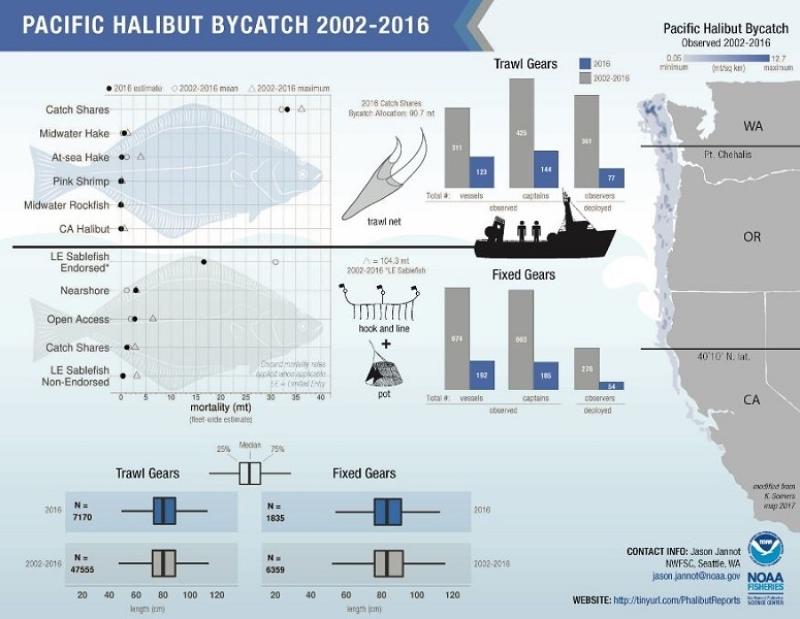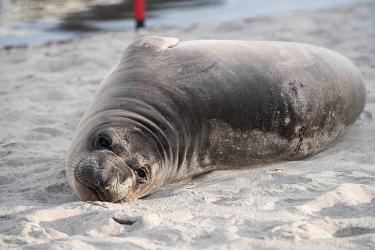Pacific halibut (Hippoglossus stenolepis) is found in coastal waters throughout the North Pacific and inhabits continental shelf areas (< 150 fm) from Washington to central California along the U.S. West Coast. Pacific halibut has long supported a directed commercial fishery in the U.S. and Canada, but it is also caught as bycatch in fisheries that target species which share habitats with Pacific halibut. The annual Pacific halibut bycatch and mortality report is used by the International Pacific Halibut Commission (IPHC) and the Pacific Fisheries Management Council (PFMC) to manage bycatch in groundfish fisheries and provides estimates bycatch and mortality for each year from 2002-2016.
The U.S. West Coast groundfish fishery is a multi-species fishery that utilizes a variety of gear types. The fishery uses trawl nets, hook-and-line gears, and fish pots to harvest multiple species defined in the Pacific Coast Groundfish Fishery Management Plan (FMP). The groundfish FMP lists over 90 species, including a variety of rockfish, flatfish, roundfish, skates, and sharks, which are found in both state (0-4.8 km) and federal waters (>4.8 km off-shore to the EEZ). Except in very limited cases, Pacific halibut caught by these fisheries is considered bycatch and must be released at-sea when possible.

In 2011, the bottom and midwater trawl portions of these fisheries shifted to catch shares management. Bottom trawl vessels have consistently been one of the largest contributors to Pacific halibut bycatch. The management shift to catch shares coincided with large reduction of Pacific halibut bycatch, benefiting both the fishers and the species.
In 2016, catch shares vessels fishing with bottom trawl nets caught 33.27 metric tons (mt) of Pacific halibut or 57% of the total 2016 mortality reported. Nevertheless, this amount is 82% lower than the 2010 bottom trawl mortality estimate – the last year before catch shares implementation. In 2016, the limited entry sablefish fishery caught 16.59 mt of Pacific halibut, or ~29% of the total 2016 bycatch reported. The report also describes historical trends in total Pacific halibut mortality for U.S. West Coast fisheries, provides maps of Pacific halibut hotspots of bycatch, and summarizes biological data collected from Pacific halibut (lengths, weights, and viabilities).
The report also summarizes Pacific halibut mortality on Catch Share vessels carrying electronic monitoring systems (EM). Current EM systems cannot account for P. halibut viability, a necessary component for estimating P. halibut mortality. Observers on Catch Shares EM vessels collected viability data from P. halibut in 2016. Results from this work suggest that P. halibut captured on EM vessels might have lower viabilities than P. halibut captured on non-EM vessels, perhaps due to spending more time out of the water. However, the number of P. halibut captured and assessed for viability on EM vessels was relatively low. Therefore, definitive conclusions about P. halibut viability on EM vessels will have to wait for more data.
At the September 2017 PFMC Meeting, the IPHC publicly thanked the NWFSC Observer Program for their work on the annual Pacific halibut bycatch report and their responsiveness to data needs. Recognition from the IPHC, the main body responsible for Pacific halibut management, indicates how important this science is for maintaining healthy Pacific halibut stocks on the U.S. West Coast.



